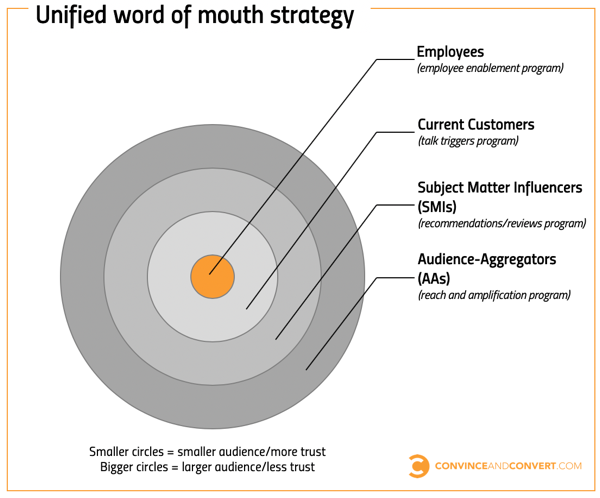
I think we can agree that:
Advertising is more expensive than ever, and in many cases, less effective than ever.
This led marketers toward creating content to gain attention, but the subsequent glut has produced an epoch where upwards of 80% of content fails.
Now, the new game in town is influencer marketing. Here’s how we define it at Convince & Convert:
Influencer Marketing Definition:
The use of people (employees, customers, third parties) to amplify business messages and drive desirable behavior among target audiences.
Influencer Marketing vs. Word of Mouth:
Is word of mouth the same as influencer marketing? Is influencer marketing a type of word of mouth? How do they work together, if they do at all? I’ve created a new, unified theory of word of mouth strategy, with a corresponding graphic, to help sort through these questions.
The problem with influencer marketing — as it’s currently being practiced by most businesses — is that it focuses almost solely on the outside ring of the four-part unified word of mouth strategy. We call them Audience-Aggregators (AAs) here at Convince & Convert.
Most companies use influencer marketing — or attempt to do so — to increase reach and boost amplification of their messages. This means that AAs are being used instead of, or as an adjunct to, advertising. But instead of a television program or magazine being the conduit for the come-on, big audience influencers (AAs) serve that role.
We’ve all seen brands make use of influencers to push products and services, most often on Instagram. In general, these efforts are most strategically appropriate if you’re targeting younger customers, as they often make buying decisions based on influencer recommendations, per this report on 11 Gen Z Word of Mouth statistics.
Does Influencer Marketing Work?
Like any other form of marketing, the answer is: sometimes. Your results may vary. Influencer marketing can absolutely work, as evidenced by this influencer marketing results study from TapInfluence.
But AAs-centered marketing programs can also be costly failures for one big reason: “audience” and “influence” are not always correlated. When it comes to the reach and amplification layer of a word of mouth strategy, most businesses seek to work with people who have the largest audience that is theoretically appropriate.
Except influencer marketing (and word of mouth in general) doesn’t have the same mechanics as a traditional ad. Word of mouth success is driven by trust, authenticity, and proximity, meaning: “How well do I know the person making this recommendation, and how much do I believe it?” If the answers are “A lot” and “A lot” then I am likely, as a person exposed to an influencer’s entreaties, to take the action requested.
Word of mouth success is driven by trust, authenticity, and proximity. #WOM
Click To Tweet
Where companies interested in influencer marketing make a false step is assuming that the relationship between audience size and audience trust is static. Instead, in many cases, as audience size grows, trust is eroded on a per-person basis. This is the same reason that companies with a large Facebook audience typically see lower engagement rates on their social media posts. When you get big, you become less relevant — almost inexorably so. And when you become less relevant, you become slightly less trusted, which reduces the likelihood that any given audience member will do what is asked of them by the influencer.
A Better Approach to Word of Mouth Strategy and Influencer Marketing
Instead of gravitating consistently to the biggest audiences, companies would be more successful in acquiring new customers if they thought about their word of mouth strategy holistically.
Every company has four possible layers of word of mouth, and each layer is apt to tell the story of the business for slightly different reasons, and to somewhat different people. The best possible approach is to build and implement programs for each of these four layers, using word of mouth to catalyze conversations and drive desired behaviors consistently across all target audiences.
Word of Mouth Strategy Layer 1: Employees
If your employees aren’t your top advocates, you don’t have a word of mouth problem: you have some combination of a corporate culture and/or hiring problem.
Your employees know more about the company than anyone else. They should have significant interest in and passion for the business as well.
These team members are also at the very center of the trust scale. If they say something about the company, chances are their friends/followers/colleagues/contacts will trust it because it’s known that the person is actually part OF the company, not an outside voice.
To benefit from this type of word of mouth, businesses should create an employee enablement program. (Two great Social Pros Podcast episodes about employee enablement here and here.) Participating employees should be kept in the loop by management, and encouraged to share company news and updates with their own networks, provided appropriate guidelines are followed.
This notion of employee enablement and “employees as influencers” has spawned an entire marketing technology sub-genre, with companies like Bambu, DynamicSignal, TrapIt, and LinkedIn Elevate being used to facilitate employees’ sharing of company snippets in social media.
However, like with the Audience-Aggregator influencer marketing programs, there are some common missteps I’d like to help you avoid:
Avoid These Employee Enablement Missteps
1. Too promotional: Businesses often ask employees to share updates that are nakedly promotional, and these “mini press releases” are both awkward for employees to share, and painful for followers of the employees to read.
2. Too frequent: Some companies ask employees to share company-related updates far too frequently, threatening to turn employees’ social feeds into a mini-me version of their employer’s social media accounts. Two to three updates per month, maximum, is how we advise our clients.
3. No offline component: These programs are entirely driven by social media word of mouth and are designed to allow employees to easily share content on Facebook, Twitter, LinkedIn with a single click. This wholly disregards the 50% of word of mouth that is offline, and ignores employees’ connectivity and influencer in non-digital spaces.
On that third strategy problem, think of it this way: in your neighborhood, irrespective of online presence and social media follower count, who is one of the most influential members of the community? It may very well be a Reverend, Minister, Pastor, Rabbi, Cleric, or Priest. While perhaps not a frequent Facebook participant, she or he may, in fact, have unique ability to drive actual behavior.
The employee enablement component of your unified word of mouth strategy should give team members the permission (and the stories) necessary to talk about your business offline: at the supermarket, the bank, and the soccer field.

Word of Mouth Strategy Layer 2: Current Customers
To us, this is the sweet spot.
The best way to grow any business is to have your customers do it for you.
As Robert Stephens, founder of GeekSquad said:
Advertising is a tax, paid by the unremarkable.
Advertising is a tax, paid by the unremarkable.
Click To Tweet
That’s not entirely true, but it’s true enough: an effective word of mouth strategy that successfully activates customers and turns them into volunteer marketers is the most cost-efficient path to revenue.
What’s challenging, however, is that very, very few companies have an actual program to turn current customers into advocates. Of the four layers of the unified word of mouth strategy, this one is the least explored; and it should be the most often used, in our estimation.
The key to making the Current Customers layer of word of mouth strategy work is to use Talk Triggers: purposeful, operational differentiators that customers notice, and talk about online and offline.
 A Talk Trigger is an unconventional choice you make that your customers don’t anticipate. DoubleTree Hotels’ warm, chocolate chip cookie presented to each guest at check-in, for example, is a terrific Talk Trigger, and one that has been in place every day for 30 years.
A Talk Trigger is an unconventional choice you make that your customers don’t anticipate. DoubleTree Hotels’ warm, chocolate chip cookie presented to each guest at check-in, for example, is a terrific Talk Trigger, and one that has been in place every day for 30 years.
In addition to giving it no attention whatsoever, there are some common missteps businesses are prone to make when activating current customers as part of a unified word of mouth strategy:
Avoid These Talk Triggers Missteps
1. Many companies falsely believe that competency creates conversation. It rarely does. We discuss things that are different, and ignore what is average. It is exceedingly difficult to become “talkable” based on quality.
2. Companies pursuing a current customers word of mouth program should focus on ONE differentiator, and executing that differentiator perfectly, every time. Do not give customers multiple stories to tell about your brand. Give them one, great story that they are compelled to share.
3. Every Talk Trigger differentiator should be accessible to every customer. Your Talk Trigger is not circumstantially available; it is omni-present. Your word of mouth-spawning difference isn’t just for your best customers, or new customers, it’s for all customers. You want the story to apply to all, not just a few.
Remember: Competency Doesn’t Create Conversation
Word of Mouth Strategy Layer 3: Subject Matter Influencers (SMIs)
Current customers can effectively spread your word of mouth message using the familiarity/recognition factor. They know people, and presumably, those people have some sort of affinity for your customers. Thus, when your customer tells a story about you to their tribe, members of that tribe take action because they “know, like, trust” your customers.
If my college roommate recommends a brand of headphones to me, I’ll consider it. I know him. I like him. I trust him.
Subject Matter Influencers (SMIs) are effective word of mouth ambassadors not because they are known by other people in a relationship sense, but because of their recognized authority on one or more topics. I trust Steve Martin to teach me comedy on MasterClass more than I trust my college roommate to do so, for example.
Winning with a unified word of mouth strategy dictates that you first uncover, and then inform relevant SMIs in your region, category, or industry. There are SMIs for every business in the world, regardless of size, type, or location. To find them, ask and answer this question: “Who knows enough about what we sell (but doesn’t work for us) that if they told people to consider our product or service, potential customers would do so?”
To put this into context, I am a SMI. I have a measure of influence about marketing, customer service, customer experience, technology, software, and a couple of outliers including tequila and BBQ.
I am not an Audience-Aggregator (AA). People do not pay attention to me because I am “famous”; they pay attention to me — insofar as they do — because of what I ostensibly know.
Find those people. Keep them informed about what your company is doing and why that’s interesting. In fact, make sure your SMIs know your Talk Trigger. Ideally, your SMIs recommend you when relevant it’s relevant because you’re a great solution, without you having to pay them.
Avoid These Subject Matter Influencers Missteps
1. Many businesses skip past SMIs entirely, choosing to work solely with AAs because of their superior reach.
2. SMIs are not often in the influence “business” the way AAs are. Thus, when working with SMIs, the relationship should not be transactional, but rather long-term and relationship-driven. You want SMIs as advocates, not paid endorsers.
3. Because their word of mouth power and overall influence is driven primarily by what they know, and secondarily by whom they know, do not be afraid to work with highly targeted and emerging SMIs.
Word of Mouth Strategy Layer 4: Audience-Aggregators (AAs)
When we think of “influencer marketing” today, this is the group that comes to mind. The celebrities and demi-celebrities that are slinging hashtags for money.
As mentioned above, this group can help power a successful word of mouth strategy. Reach does matter, after all. But at what cost?
For example, if an AA with one million followers is able to convince .5% of them to click a link, that will yield 5,000 clicks. If a SMI with 100,000 followers is able to convince 1.5% of them to click a link, that will yield 1,500 clicks. But, from a cost/benefit perspective, the current state of influencer marketing dictates that in almost every case the SMI will be dramatically less expensive to work with, if fees are necessary at all. Your mileage may vary.
Another issue with AAs as commonly executed is that their work is almost entirely online. This is because it’s easier to locate big-scale influencers using software that purports to measure audience and impact, and it’s easier for the influencers themselves to create short messages on behalf of companies in social media environments like Instagram.
However, given that 50% of word of mouth happens offline, and given that word of mouth that occurs offline is often more persuasive than online word of mouth (according to our Chatter Matters Word of Mouth Report) pegging a word of mouth strategy entirely to online influencers is like being a movie critic who only watches trailers; you’re not really getting the whole story.
Avoid These Influencer Marketing Missteps
1. Companies almost reflexively think of influencers (and word of mouth, for that matter) as a way to amplify marketing messages. Don’t ignore the other three layers.
2. Companies often seek out the largest audience, instead of the most effective drivers of behavior.
3. Influencer marketing among AAs is almost entirely online, missing 50% of the word of mouth ecosystem.
Done well, word of mouth marketing is the most effective and cost-effective way to grow any business. After all, for thousands of years, it was the ONLY form of marketing. Somewhere along the way, however, we started to take it for granted.
In an era where most companies have a marketing strategy, a digital strategy, a content strategy, a social strategy, a PR strategy and more; very few have a defined word of mouth strategy.
Some organizations point to their use of influencer marketing (or even social media) as proof that they do, in fact, have a defined plan for catalyzing conversations.
But as described in this piece, and illustrated in my graphic, influencer marketing (in both the SMI and AA variants), is just a piece of a unified word of mouth strategy. As for social media? It’s just one of the places your story can be told.
If we can help you create, implement, improve, or measure your unified word of mouth strategy, contact us and we’ll set up a free call with one of our strategists.
The post The Ultimate Unified Word of Mouth Strategy appeared first on Convince and Convert: Social Media Consulting and Content Marketing Consulting.
from Convince and Convert: Social Media Consulting and Content Marketing Consulting http://bit.ly/2RNT4Js




No comments:
Post a Comment